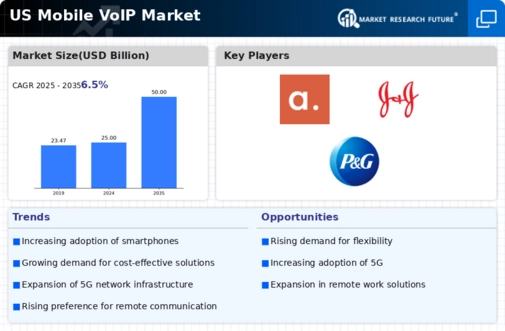The mobile VoIP market in the US is characterized by a dynamic competitive landscape, driven by rapid technological advancements and evolving consumer preferences. Key players such as Google Voice (US), Zoom (US), and WhatsApp (GB) are strategically positioned to leverage their existing user bases and technological capabilities. Google Voice (US) focuses on enhancing its integration with other Google services, thereby creating a seamless user experience that encourages adoption. Zoom (US), traditionally known for its video conferencing solutions, is expanding its VoIP offerings to include more robust communication tools, indicating a shift towards a more integrated communication platform. WhatsApp (GB), with its vast global reach, continues to innovate by introducing features that enhance user engagement and security, thereby solidifying its market presence.
The business tactics employed by these companies reflect a trend towards localization and optimization of services. The market structure appears moderately fragmented, with several players vying for market share, yet dominated by a few key entities that influence pricing and service offerings. This competitive environment fosters innovation, as companies strive to differentiate themselves through unique features and superior user experiences.
In October 2025, Zoom (US) announced the launch of a new VoIP service aimed at small businesses, which integrates seamlessly with its existing video conferencing tools. This strategic move is significant as it not only broadens Zoom's service portfolio but also positions the company to capture a growing segment of the market that seeks comprehensive communication solutions. By catering to small businesses, Zoom (US) is likely to enhance customer loyalty and increase its market penetration.
In September 2025, Google Voice (US) introduced advanced AI-driven features designed to improve call quality and user experience. This initiative underscores the company's commitment to leveraging artificial intelligence to enhance its service offerings. The integration of AI is expected to provide users with more reliable connections and personalized experiences, which could potentially lead to increased user retention and satisfaction.
In August 2025, WhatsApp (GB) rolled out end-to-end encryption for voice calls, reinforcing its commitment to user privacy and security. This strategic action is particularly relevant in an era where data security is paramount for consumers. By prioritizing privacy, WhatsApp (GB) not only strengthens its brand reputation but also differentiates itself from competitors who may not offer similar levels of security.
As of November 2025, the competitive trends in the mobile VoIP market are increasingly defined by digitalization, AI integration, and a focus on user-centric innovations. Strategic alliances among companies are shaping the landscape, as partnerships enable enhanced service offerings and technological advancements. Looking ahead, competitive differentiation is likely to evolve from traditional price-based strategies to a focus on innovation, technology integration, and supply chain reliability, suggesting a shift towards a more sophisticated competitive environment.

















Leave a Comment